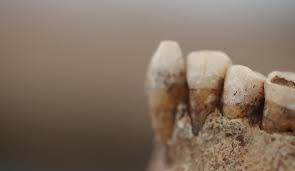Italy: New study shows the evolution of eating

Rome: Archaeologists identified two major shifts in Italian oral bacteria from the time of the prehistoric hunter-gatherers 33,000 years ago to the first farmers, and again before the Copper Age
It stands to reason that our eating habits have changed since pre-agricultural times, let alone following the industrial revolution that brought us the ultra-processed chicken nugget and potato chip. Now, a new study sheds light on the evolution of eating habits in Italy over the last 33,000 years, before and after the advent of agriculture, with the help of none other than ancient oral bacteria.
The paper, published in Nature Communications, correlates archaeological evidence with changes in the microbial populations of human mouths by analyzing ancient DNA embedded in dental plaque of 76 people who lived 33,000 to 4,000 years ago, says Andrea Quagliariello of the University of Padova, and colleagues.
Specifically the study involved the dental calculus of nine hunter-gatherers found in Paglicci Cave who lived between 33,000 to 13,000 years ago, and 67 samples from the Neolithic to the Copper ages (8,200 to 4,200 years ago). Paglicci Cave by the way was rich in Paleolithic finds and artwork, including pictures of horses.
Change in diet can transform our oral populations. Shifting from fresh eatables to a “Western diet” featuring farmed meat, sugar, dairy, refined oils, and processed and ultra-processed grains causes pathological microbiome changes – meaning, “Western” consumers are relatively prone to cavities.
To identify oral bacteria from 33,000 years ago to the Copper Age, the researchers performed ancient DNA analysis of the plaque itself to obtain genetic traces of the incumbent bacteria.
This isn’t about slaking idle curiosity. Our oral bacterial communities profoundly affect our health, and little has been known about coevolution of our rich oral microbiomes and our lifestyle.

Ancient DNA analysis has had startling results, such as the revelation that we interbred with other human species: we hadn’t known about our multipronged ancestry. This study is rather less staggering, since one would expect oral microbiome changes as nomadic pre-agricultural hunter-gatherers transited to sedentary early farmers, who transited to commuters stalking burgers and chips.
Indeed, changes were found – but the team detected not one but two major transitions, which seem to coincide with subsistence strategy changes.
It is true that today’s urban folk and modern hunter-gatherers have differences in oral bacteria. However, studies attempting to detect microbiome changes in ancient populations have produced a mixed picture, not made easier by the absence of a clear archaeological boundary between pre- and post-Neolithic. The agrarian revolution was not a monolithic event, the authors observe.
There are other snags. Archaeology can find evidence of crop and animal domestication, and conclude that farming happened. But it’s nigh-on impossible to assess the quantities of food being produced and eaten by a prehistoric community, and how much they hauled home from the wild. Prehistoric foodstuff storage strategies, if any, remain a mystery – though archaeologists have identified a model of a grain silo in Israel from 7,200 years ago, and if there was a model, there was a real one. Also, the team of Prof. Ron Barkai postulate that hundreds of thousands of years ago, pre-sapiens hominins were storing bones in Qesem Cave, to break them open and extract the marrow weeks later.
Another puzzling aspect is that prehistoric peoples continued to hunt massively after the advent of animal husbandry, using vast “kite” traps mainly in arid areas of the Near East, central Asia and Africa, but pretty much everywhere really. If anything, at least in some areas, they apparently hunted more in the post-Neolithic period.
Anyway, the new study overcomes geographical variation in oral infestation by confining itself to the heel of Italy’s boot – a southeastern region known as Apulia (aka Puglia). The team analyzed the plaque DNA, and food particles stuck in the plaque, in 76 people who had lived 31,000 to 4,200 years ago: from the Late Paleolithic, the Neolithic and the Copper Age.
Behold, the researchers did find that the bacterial populations in mouths altered with change in the food types in Apulia. Twice.
Agriculture apparently emerged independently in the Far East, the Near East, the Americas and Africa. In the Near East, food production emerged about 10,000 years ago; in Italy, agriculture first began to emerge in Apulia about 8,200 years ago. The know-how in Apulia came from early farmers sailing out of the Levant, the team says. Beforehand, the land had been sparsely populated by hunter-gatherers.
Remarkably, the prehistoric hunter-gatherers were found to be quite uniform in their oral microbiomes, despite apparent population replacements following the Last Glacial Maximum.
The homogeneity may reflect a long-standing subsistence strategy based on heavy consumption of animals and starchy plants – in fact, a wider range of plants than during the subsequent Neolithic period, according to the analysis of the microfragments of food embedded in the calculus. (Note that hunter-gatherers didn’t just hunt, they also gathered and would eat wild grains such as oats, ground using stones.)
Come the Neolithic, the early farmers settled down in small villages and evinced ceramic skills, making “impressed ware”: pots with simple round bottoms and decorated by pressing something into the still-moist clay: sticks, combs, fingernails or seashells – and their diet became richer in carbs at the expense of protein. That is when there was the first major shift in microbiome. It is the second one that surprised, in the last part of the Neolithic period.
And yes, this study did detect signs of declining dental heath as the proportion of carbs increased. The archaeologists also suspect – based on the presence of diatoms in the samples – that the early farmers were drinking foul water, which would have done their health no favors.
In one wrinkle, while bacterial populations in the mouths of the Neolithic at one site – Cavallo Cave – were much the same, archaeologists also discerned different funerary models at the same site. They think it may reflect social differentiation.





